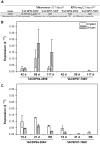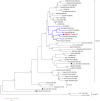Biomass Accumulation and Cell Wall Structure of Rice Plants Overexpressing a Dirigent-Jacalin of Sugarcane (ShDJ) Under Varying Conditions of Water Availability
- PMID: 30815002
- PMCID: PMC6381051
- DOI: 10.3389/fpls.2019.00065
Biomass Accumulation and Cell Wall Structure of Rice Plants Overexpressing a Dirigent-Jacalin of Sugarcane (ShDJ) Under Varying Conditions of Water Availability
Abstract
A sugarcane gene encoding a dirigent-jacalin, ShDJ, was induced under drought stress. To elucidate its biological function, we integrated a ShDJ-overexpression construction into the rice Nipponbare genome via Agrobacterium-mediated transformation. Two transgenic lines with a single copy gene in T0 were selected and evaluated in both the T1 and T4 generations. Transgenic lines had drastically improved survival rate under water deficit conditions, at rates close to 100%, while WT did not survive. Besides, transgenic lines had improved biomass production and higher tillering under water deficit conditions compared with WT plants. Reduced pectin and hemicellulose contents were observed in transgenic lines compared with wild-type plants under both well-watered and water deficit conditions, whereas cellulose content was unchanged in line #17 and reduced in line #29 under conditions of low water availability. Changes in lignin content under water deficit were only observed in line #17. However, improvements in saccharification were found in both transgenic lines along with changes in the expression of OsNTS1/2 and OsMYB58/63 secondary cell wall biosynthesis genes. ShDJ-overexpression up-regulated the expression of the OsbZIP23, OsGRAS23, OsP5CS, and OsLea3 genes in rice stems under well-watered conditions. Taken together, our data suggest that ShDJ has the potential for improving drought tolerance, plant biomass accumulation, and saccharification efficiency.
Keywords: RT-qPCR; monocot plants; overexpression; transgenic plants; water deficit.
Figures







Similar articles
-
AtCesA8-driven OsSUS3 expression leads to largely enhanced biomass saccharification and lodging resistance by distinctively altering lignocellulose features in rice.Biotechnol Biofuels. 2017 Sep 16;10:221. doi: 10.1186/s13068-017-0911-0. eCollection 2017. Biotechnol Biofuels. 2017. PMID: 28932262 Free PMC article.
-
Overexpression of ScMYBAS1 alternative splicing transcripts differentially impacts biomass accumulation and drought tolerance in rice transgenic plants.PLoS One. 2018 Dec 5;13(12):e0207534. doi: 10.1371/journal.pone.0207534. eCollection 2018. PLoS One. 2018. PMID: 30517137 Free PMC article.
-
Enhanced Gene Expression Rather than Natural Polymorphism in Coding Sequence of the OsbZIP23 Determines Drought Tolerance and Yield Improvement in Rice Genotypes.PLoS One. 2016 Mar 9;11(3):e0150763. doi: 10.1371/journal.pone.0150763. eCollection 2016. PLoS One. 2016. PMID: 26959651 Free PMC article.
-
Overexpression of an evolutionarily conserved drought-responsive sugarcane gene enhances salinity and drought resilience.Ann Bot. 2019 Oct 29;124(4):691-700. doi: 10.1093/aob/mcz044. Ann Bot. 2019. PMID: 31125059 Free PMC article.
-
Overexpression of a Stress-Responsive NAC Transcription Factor Gene ONAC022 Improves Drought and Salt Tolerance in Rice.Front Plant Sci. 2016 Jan 22;7:4. doi: 10.3389/fpls.2016.00004. eCollection 2016. Front Plant Sci. 2016. PMID: 26834774 Free PMC article.
Cited by
-
Comparative transcriptomics and proteomics analysis of the symbiotic germination of Paphiopedilum barbigerum with Epulorhiza sp. FQXY019.Front Microbiol. 2024 Mar 18;15:1358137. doi: 10.3389/fmicb.2024.1358137. eCollection 2024. Front Microbiol. 2024. PMID: 38562471 Free PMC article.
-
Genome-wide identification and expression analysis of dirigent-jacalin genes from plant chimeric lectins in Moso bamboo (Phyllostachys edulis).PLoS One. 2021 Mar 16;16(3):e0248318. doi: 10.1371/journal.pone.0248318. eCollection 2021. PLoS One. 2021. PMID: 33724993 Free PMC article.
-
Leaf transcriptome profiling of contrasting sugarcane genotypes for drought tolerance under field conditions.Sci Rep. 2022 Jun 1;12(1):9153. doi: 10.1038/s41598-022-13158-5. Sci Rep. 2022. PMID: 35650424 Free PMC article.
-
The Crystal Structure of the Defense Conferring Rice Protein OsJAC1 Reveals a Carbohydrate Binding Site on the Dirigent-like Domain.Biomolecules. 2022 Aug 17;12(8):1126. doi: 10.3390/biom12081126. Biomolecules. 2022. PMID: 36009020 Free PMC article.
-
Differential Response of Two Tomato Genotypes, Wild Type cv. Ailsa Craig and Its ABA-Deficient Mutant flacca to Short-Termed Drought Cycles.Plants (Basel). 2021 Oct 27;10(11):2308. doi: 10.3390/plants10112308. Plants (Basel). 2021. PMID: 34834671 Free PMC article.
References
-
- Aljanabi S. M., Forget L., Dookun A. (1999). An improved and rapid protocol for the isolation of polysaccharide- and polyphenol-free sugarcane DNA. Plant Mol. Biol. Rep. 17:281 10.1023/A:1007692929505 - DOI
LinkOut - more resources
Full Text Sources

